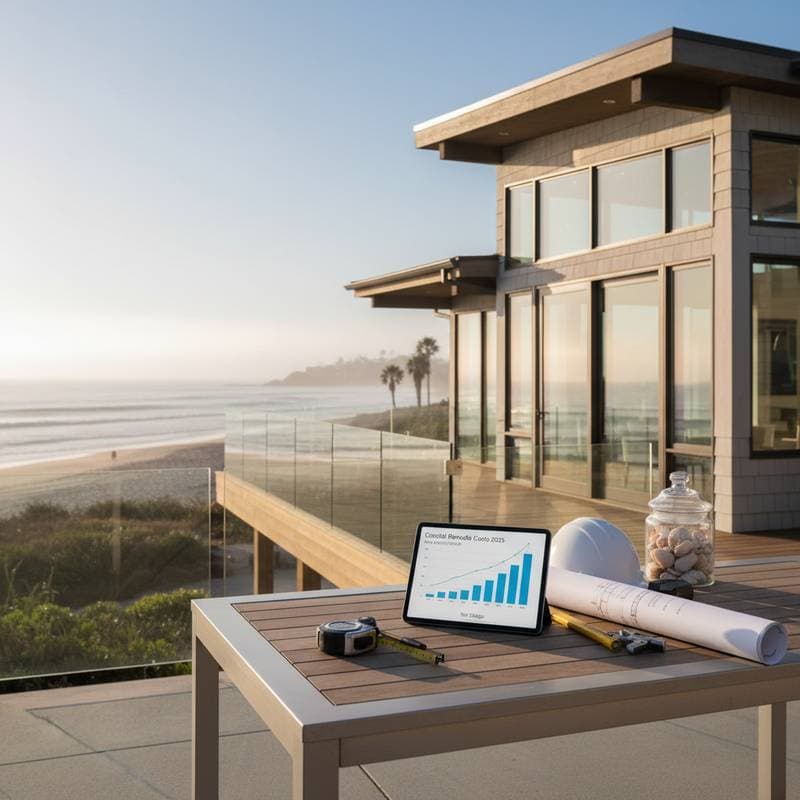2025 Coastal Remodel Costs: What Homeowners Actually Pay
Remodeling a home in a coastal location presents unique challenges and opportunities. The average cost for such a project in 2025 falls between $45,000 and $180,000, influenced by the scope of work, material selections, and necessary structural enhancements. In San Diego, a representative mid-sized coastal market, the typical expenditure reaches approximately $110,000 for a comprehensive renovation. Elevated expenses stem from environmental factors like salt-laden air and high humidity, combined with rigorous building regulations that demand resilient materials and skilled labor.
This resource provides a detailed examination of coastal remodel costs, identifies key pricing influences, and delivers strategies for effective budgeting to avoid unnecessary expenditures.
Cost Breakdown by Project Area
Kitchen Remodel
Coastal kitchen renovations generally range from $30,000 to $90,000. Homeowners often opt for open-concept designs featuring quartz countertops and corrosion-resistant stainless-steel appliances. Cabinetry represents about 30 percent of the total budget, so selecting durable options early proves essential.
High-cost elements include custom cabinetry with marine-grade finishes, oversized windows that capture ocean vistas, and durable stone or quartz surfaces. To manage expenses, consider semi-custom cabinets paired with standard appliances that meet coastal durability standards.
Image: Bright coastal kitchen featuring white cabinetry and expansive ocean-view windows
Bathroom Remodel
Bathrooms in coastal settings endure significant moisture and salt exposure, which accelerates wear on fixtures. Renovation costs span $15,000 to $40,000, with emphasis on waterproofing measures and robust ventilation systems to prevent mold growth.
Preferred enhancements encompass porcelain or natural stone tiles for flooring and walls, frameless glass enclosures for showers, and high-efficiency exhaust fans. Integrating these features not only extends fixture lifespan but also improves daily usability in humid conditions.
Image: Spa-inspired coastal bathroom with light stone tiling and a prominent mirror
Exterior and Deck Updates
Exterior work constitutes a substantial portion of the budget due to rapid deterioration from coastal elements. Allocations for siding, painting, and deck enhancements typically total $30,000 to $100,000.
Suitable materials involve fiber cement siding for weather resistance, composite decking that withstands moisture without splintering, and stainless-steel railings to resist rust. Prioritizing these selections ensures the home's facade maintains appeal and integrity over time.
Image: Contemporary coastal deck with composite surfaces and glass railings facing the beach
Windows and Doors Replacement
Updating windows and doors incurs costs of $10,000 to $40,000. Local codes in coastal zones mandate impact-resistant glass to withstand storms and frames engineered to prevent corrosion, enhancing both security and energy efficiency.
Select double- or triple-pane options with low-emissivity coatings to minimize heat gain from intense sunlight. These upgrades reduce utility bills while complying with regulations, providing long-term financial benefits.
Roofing Replacement
Installing a new roof on a coastal property costs between $15,000 and $40,000, varying by material choice. Metal or clay tile roofs outperform traditional asphalt shingles in resisting salt corrosion and high winds.
Evaluate the roof's pitch and exposure level when selecting materials; steeper roofs may require additional reinforcement. Professional assessments help identify underlying issues like weakened sheathing before installation begins.
Strategies for Effective Budgeting and Planning
Coastal remodeling demands strategic foresight to align costs with desired outcomes. The following steps guide homeowners through the process.
Establish a Realistic Budget
Determine the maximum amount available for the project upfront. Distribute funds across specific areas, such as 40 percent for interiors and 30 percent for exteriors, while reserving 10 to 20 percent as a contingency for unforeseen issues like hidden water damage.
Prioritize Investments with Strong Returns
Direct resources toward kitchens, bathrooms, and exterior elements, as these yield the greatest value appreciation. For instance, a modernized kitchen can attract buyers seeking updated, functional spaces in desirable coastal markets.
Integrate Durability with Design Choices
Coastal aesthetics emphasize airy layouts, neutral palettes, and natural textures, yet functionality must prevail. Select UV-resistant paints, mildew-proof fabrics, and sealed woods to combat environmental stressors without sacrificing visual appeal.
Obtain Quotes from Qualified Professionals
Solicit itemized proposals from at least three contractors licensed in coastal construction. Evaluate not only pricing but also their track record with similar projects and knowledge of regional permitting requirements to ensure compliance and quality.
Implement Phased Renovations
For larger budgets, divide the work into stages: address foundational elements like roofing and exteriors first to protect the structure, followed by interior spaces. This approach spreads costs over time and allows adjustments based on initial results.
Evaluating Return on Investment
Coastal renovations extend beyond aesthetics to safeguard assets and elevate market value. The table below outlines average returns for common projects, based on national data adjusted for coastal influences.
| Project Type | Average ROI | Key Considerations |
|---|---|---|
| Kitchen remodel | 75% | Appeals to buyers seeking modern functionality |
| Bathroom remodel | 70% | Improves usability in high-moisture areas |
| Exterior siding | 65% | Enhances first impressions and weather resistance |
| Deck addition | 68% | Increases outdoor living options |
| Full remodel | 80% | Combines multiple upgrades for maximum impact |
Durable enhancements that address local conditions often exceed these averages by lowering ongoing maintenance expenses and boosting appeal in competitive real estate markets.
Steps to Launch Your Coastal Renovation
Embark on your project by clarifying renovation goals, such as expanding living areas or fortifying against erosion. Assemble a team of experts familiar with coastal challenges, secure financing aligned with your budget, and monitor progress to stay on track. These measures transform potential obstacles into opportunities, resulting in a home that thrives in its seaside environment while delivering enduring enjoyment and equity growth.

